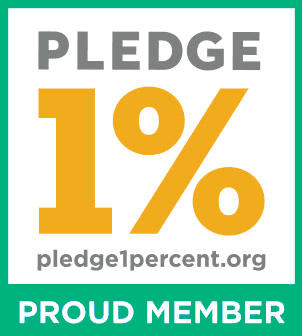10 Most Sustainable Maternity Clothing Brands: The Conscious Consumer’s Guide
Affiliate Disclosure
Hey fellow impactful ninja ?
You may have noticed that Impactful Ninja is all about providing helpful information to make a positive impact on the world and society. And that we love to link back to where we found all the information for each of our posts.
Most of these links are informational-based for you to check out their primary sources with one click.
But some of these links are so-called "affiliate links" to products that we recommend.
Why do we add these product links?
First and foremost, because we believe that they add value to you. For example, when we wrote a post about the environmental impact of long showers, we came across an EPA recommendation to use WaterSense showerheads. So we linked to where you can find them. Or, for many of our posts, we also link to our favorite books on that topic so that you can get a much more holistic overview than one single blog post could provide.
And when there is an affiliate program for these products, we sign up for it. For example, as Amazon Associates, we earn from qualifying purchases.
What do these affiliate links mean for you?
First, and most importantly, we still only recommend products that we believe add value for you.
When you buy something through one of our affiliate links, we may earn a small commission - but at no additional costs to you.
And when you buy something through a link that is not an affiliate link, we won’t receive any commission but we’ll still be happy to have helped you.
What do these affiliate links mean for us?
When we find products that we believe add value to you and the seller has an affiliate program, we sign up for it.
When you buy something through one of our affiliate links, we may earn a small commission (at no extra costs to you).
And at this point in time, all money is reinvested in sharing the most helpful content with you. This includes all operating costs for running this site and the content creation itself.
What does this mean for me personally?
You may have noticed by the way Impactful Ninja is operated that money is not the driving factor behind it. It is a passion project of mine and I love to share helpful information with you to make a positive impact on the world and society. However, it's a project in that I invest a lot of time and also quite some money.
Eventually, my dream is to one day turn this passion project into my full-time job and provide even more helpful information. But that's still a long time to go.
Stay impactful,
Amid growing concerns about the textile industry’s environmental impact, there is pressure to find greener clothes for your wardrobe, from seasonless items to those you need during a special period in your life—such as a bra for nursing. Unfortunately, fashion greenwashing makes it harder for you and all other consumers to figure out which clothing brands offer the most eco-friendly garments. So, we had to ask: Which are the most sustainable maternity clothing brands?
The most sustainable maternity clothing brands include Isabella Oliver, Girlfriend, and Luna + Sun, which use low-impact materials, minimize waste, and strive for textile circularity. In addition, Underprotection and Pact commit to reducing their carbon footprints and manufacturing responsibly.
Whether you are searching for some pregnancy leggings or a practical top for nursing to add to your wardrobe without negatively impacting the soil, the water, the animals, and other people, there is a brand for you. So, let’s keep reading to learn more about the most sustainable maternity clothing brands and how they ensure sustainable, ethical practices.
Here’s How We Selected the Most Sustainable Maternity Clothing Brands
Maternity clothing is an apparel category that, by nature, is temporary in its use. Thus, buying and landfilling these items can have a significant impact, especially if they contain certain stretch materials like fossil-derived spandex (or elastane).
“Sustainable: The ability to be maintained at a certain rate or level | Avoidance of the depletion of natural resources in order to maintain an ecological balance”
Oxford
The brands on this list were chosen based on their commitment and actions to promote sustainable practices while reducing the environmental impacts of the textile industry.
They are transparent about their materials, processes, and workforce management within their supply chain.
Some brands focus their efforts on reducing waste and optimizing natural resources while others strive to reduce the carbon footprint of their clothes.
All of these brands share the commitment to reshape the textile industry toward a more sustainable and Earth-friendly sector.
These Are the 10 Most Sustainable Maternity Clothing Brands
Most Sustainable Maternity Clothing Brands
Overall, these maternity clothing brands are sustainable. Yet, they take various approaches to reduce environmental impacts and uphold ethical standards. Let’s dive into each brand and find out more.
Isabella Oliver: A Maternity Clothing Brand Striving for Circularity


“We design environmentally, ethically and socially conscious maternity style for mamas-to-be. Our collections are focussed on luxuriously comfortable and flattering pieces that you can wear throughout your pregnancy and beyond. ”
Isabella Oliver
🌎
How do they ensure their sustainability?
Isabella Oliver ensures sustainability by keeping garments in use for longer, reducing waste generated by fashion, and striving for circularity in their textiles.
- They approach textile circularity with subscription and rental schemes for maternity dresses as well as versatile wardrobe staples. These waste-reduction offers are especially valuable for temporary maternity items. The brand also has a pre-loved collection, composed of items they’ve repurposed and recycled from old Isabella Oliver clothes returned by customers. On top of that, Isabella Oliver provides care instructions for each type of fabric used in their collection, furthering their efforts to keep materials and clothes longer in circulation.
- Additionally, Isabella Oliver prioritizes sourcing eco-friendly textiles and packaging materials. Most of their fabrics are derived from natural fibers, such as organic cotton, TENCELTM, and EcoVeroTM. The responsible sourcing of their wood-based fabrics—the lyocell and viscose fibers sourced from Lenzing—is also guaranteed in their Canopy Pledge. Isabella Oliver also uses a GRS-certified blend between TENCELTM and recycled fibers (sheep wool, cashmere, and polyamide).
- Regarding packaging, the brand exclusively sources recycled paper packaging that is completely plastic-free, biodegradable, and recyclable. Other incentives to reduce their environmental impacts include chemical-free ozone wash for returned clothes, as well as low-impact renewable energy in processing and recycling.
- Finally, they are a Zero-Waste company, meaning that 90% of their “waste” is neither landfilled nor incinerated.
🌐
How do they ensure their ethics?
Isabella Oliver ensures their ethics by upholding all their tier 1 suppliers and some of their 2 suppliers to their rigorous Code of Conduct. They are also a living wage employer.
🤝
Are they part of any giving-back programs?
Isabella Oliver donates at least 10% of their annual profits to charities. For example, the brand partners with Oxfam in the fight against poverty, giving the charity a percentage of revenue from their Pre-Loved collection.
🛍️
What is their product range?
- Best for: womenswear
- Product range: maternity dresses, maternity tops, maternity T-shirts, maternity leggings, maternity pants, maternity jeans, maternity knitwear, maternity loungewear, maternity hosiery
- Price range: $$$
- Size range: XS–XXL
Girlfriend Collective: Essential and Timeless Activewear Made Out of Recycled Materials
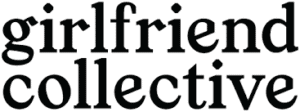

“We make everything locally in small batches to make sure we don’t have a negative impact on the environment.”
Girlfriend Collective
🌎
How do they ensure their sustainability?
Girlfriend Collective’s sustainability efforts start with using recycled and recyclable textile and packing materials.
- Their clothes are made from recycled materials such as post-consumer water bottles, fishing nets retrieved from the seas, fabric scraps, and other waste. On top of that, their packaging is 100% recycled and recyclable. After their clothes are dyed, all the wastewater is sent to a treatment plant 100 feet away. Treated water that meets safety standards is released into the waterway, while mud dye is donated to a pavement facility to be turned into paving stones.
- Additionally, they help prevent microfiber release with a branded microfiber filter. Their program “Recycle. Reuse. Regirlfriend.” collects old Girlfriend Collective compressive leggings and upcycles them into new pieces that can be worn again and again, reducing waste while moving toward a more circular fashion model.
- Lastly, Girlfriend Collective partners with EcoCart to provide a carbon-neutral option for all orders placed on their site to offset the carbon footprint of their products.
🌐
How do they ensure their ethics?
Girlfriend Collective’s facilities are fully certified by Social Accountability International – SA8000. An SA8000 certification guarantees safe working conditions, the right to unionize, and no forced or child labor. They also ensure all workers in their supply chain are paid fair wages and provided with free lunches and guided exercise breaks.
🤝
Are they part of any giving-back programs?
Girlfriend Collective is not known to be part of any giving-back programs.
🛍️
What is their product range?
- Best for: womenswear
- Product range: dresses, hoodies, sweatshirts, activewear, sportswear, maternity wear, tops, blouses, T-shirts, stockings, tights, shorts, lingerie, plus-size
- Price range: $$$
- Size range: 2XS–6XL
Luna + Sun: Sustainable Linen Womenswear With a Focus on Motherhood
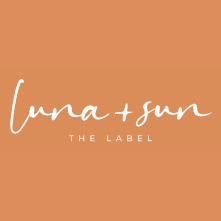

“Luna + Sun is not just about ethical and sustainability-made clothing; it’s about fostering a community with like-minded women who inspire and uplift each other.”
Luna + Sun
🌎
How do they ensure their sustainability?
Luna + Sun ensures their sustainability by sourcing eco-friendly materials, minimizing textile waste, and reducing their climate impact.
- Firstly, they use 100% linen fabrics certified by OEKO-TEX® STANDARD 100 for their garments. In addition, their components are also plant-based, including cotton-natural rubber elastics, organic cotton labels, linen hanging ribbons, and corozo buttons. Regarding packaging, Luna + Sun also takes an eco-friendly stance. They use tote bags from linen and satchels made from 100% compostable materials. Their thank-you notes and swing tags are also made from recycled paper.
- Secondly, Luna + Sun has several approaches toward reducing textile waste during manufacturing, including employing pattern layout techniques that maximize fabric use, making gifts and small items with end rolls, and home composting the smallest pieces of fabric. The brand also partners with other organizations like UPPAREL, AirRobe, and Rntr to take back, recycle, and rent their garments to keep garments in circulation longer and avoid clothing pieces ending up in landfills before it is necessary. Additionally, all returned items are resold or mended and then resold instead of being sent to a landfill, a common practice of fast fashion.
🌐
How do they ensure their ethics?
Luna + Sun ensures their ethics by being transparent about their supply chain. They publicly share their suppliers for fabric and garment components and their manufacturing partners. Based in Brisbane, their factory is certified by Ethical Clothing Australia (ECA), ensuring that workers are paid appropriately, receive their minimum legal entitlements, and work in safe conditions.
🤝
Are they part of any giving-back programs?
Luna + Sun partners with One Tree Planted to support their reforestation efforts. Customers have an option at check out to plant a tree. For every tree planted by a customer, Luna + Sun will plant another one. They also donate fabric scraps to The Social Studio to support their work helping migrants and refugees.
🛍️
What is their product range?
- Best for: womenswear
- Product range: dresses, tops, pants, maternity wear, accessories
- Price range: $$$
- Size range: S–L
Underprotection: Fashionable and Sustainable Lingerie
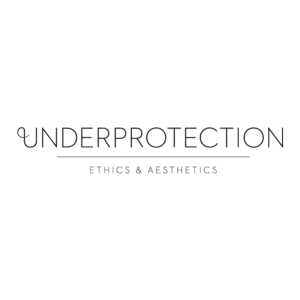

“We always strive to make the most sustainable choices even if it is not necessarily the most economically sensible choice, but for us, it is not only a business, it’s a lifestyle and a belief that the future must and can be greeners. It is our goal to always improve – in everything we do”
Stephan Rosenkilde, Co-Founder of Underprotection
🌎
How do they ensure their sustainability?
Underprotection ensures their sustainability by sourcing low-impact textile and packaging materials, prolonging their garments’ lifespan, and striving toward textile circularity.
- Firstly, they use a high proportion of eco-friendly fabrics, including TENCELTM Lyocell, organic cotton, recycled wool, and RWS-certified responsible sheep wool. All their synthetic fabrics come from
- recycled sources with the Global Recycle Standard certification, be it polyester, nylon, or elastane (spandex). On top of that, Underprotection also has fabrics made by utilizing by-product waste (banana leaves from the fruit industry and sour milk from the milk industry), helping to cut down waste and lower their environmental impacts. Regarding packaging materials, they opt for recycled or biodegradable materials.
- Secondly, the brand designs their products with quality and durability in mind to make them last, offers guaranteed repairs within the first two years, provides first-aid rewards for customers who fix up items themselves instead of replacing them, and equips customers with detailed wash and care instructions for various types of fabrics. All these efforts aim to extend the lifespan of a garment and reduce its environmental cost.
- Thirdly, regarding their efforts toward textile circularity, they have a take-back program to give worn-out Underprotection pieces a second life, and an Upcycled collection that utilizes returned Underprotection products through their Take-back program, which covers leftover fabrics and discarded items.
- Last but not least, their main supplier uses solar-powered energy and harvests rainwater.
🌐
How do they ensure their ethics?
Underprotection ensures their ethics by holding a transparent and responsible supply chain. They bind their suppliers with a Code of Conduct, which covers all of the ILO’s Fundamental Principles and Rights at Work.
- Their suppliers have certifications that guarantee proper working conditions and a fair wage, including WRAP (Worldwide Responsible Accredited Production), Sedex, GOTS, and BSCI (Business Social Compliance Initiative).
- Underprotection also audits most of the final stage of production.
🤝
Are they part of any giving-back programs?
Underprotection partners with various organizations to give back to underprivileged communities and the Earth. For example, they plant a fixed 150 trees every month in their partnership with Treeapp. Another example is their partnership with the ReSea Project, an organization on a mission to end the ocean plastic crisis. Part of their sales go to support the cause.
🛍️
What is their product range?
- Best for: womenswear
- Product range: lingerie, loungewear, swimwear
- Price range: $$$
- Size range: XS–XL
Pact: Stylish, Comfortable, Essential Clothing Made Ethically and Sustainably

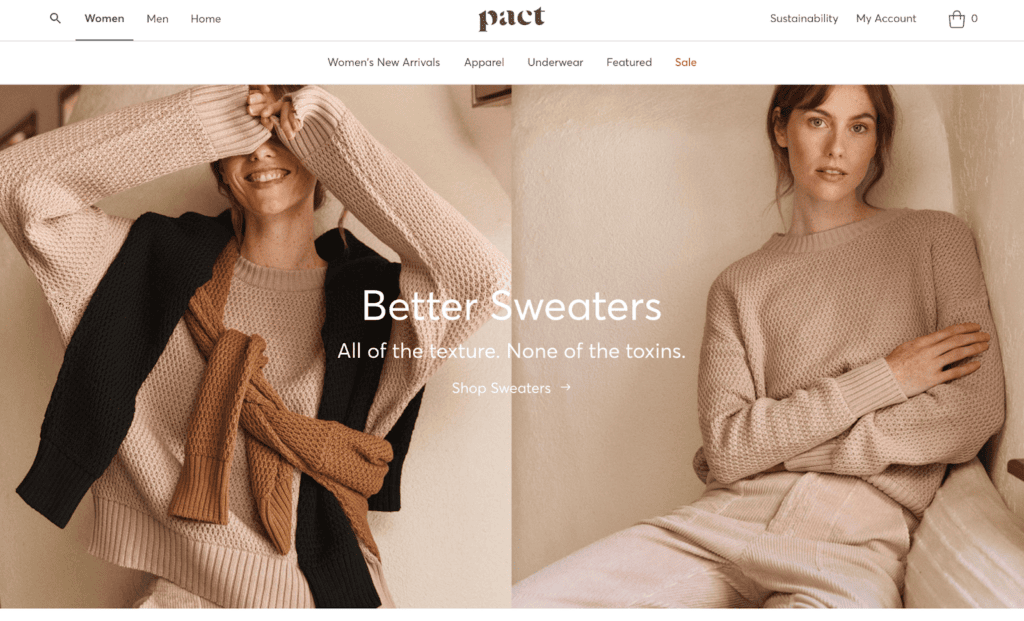
“We believe the planet, and the people on it, should always come first in fashion.”
Pact
🌎
How do they ensure their sustainability?
Pact ensures sustainability by using low-impact textile and packaging materials, offsetting the carbon impact of all their products, and facilitating the donation of used clothes to reduce waste.
- They use a high proportion of eco-friendly fabrics, including organic fabrics made with GOTS-certified cotton.
- Additionally, their clothes are delivered in VelaTM paper bags. These bags are made with carbon-neutral, FSC-certified, recyclable paper.
- Pact also partners up with SimpliZero. This partnership enables measuring the impact of every product Pact makes and offsetting it through reforestation, renewable energy, and community projects sequestering carbon from the atmosphere.
- Their Give Back Box incentive enables their customers to reuse the boxes their Pact orders came in and donate their used clothes to local charities with the postal fee paid for by Pact.
🌐
How do they ensure their ethics?
Pact uses Fair Trade CertifiedTM factories, providing safe working conditions, community support, and additional development funds to workers in their supply chain. They also trace most of their supply chain, including all of the final stages of production.
🤝
Are they part of any giving-back programs?
Pact is not known to be part of any giving-back programs.
🛍️
What is their product range?
- Best for: womenswear, menswear
- Product range: dresses, hoodies, sweatshirts, activewear, sleepwear, maternity wear, T-shirts, underwear, jumpsuits, playsuits, plus-size
- Price range: $$$
Boob Design: Sustainably Made Clothes for Pregnancy and Breastfeeding


“When you buy a garment from Boob, you buy a product that has been produced with care. Some of this you can see and feel when you wear our clothes. What may be less obvious, is the care we show for production, the people, and the environment. To us, caring is a given – we make clothes for the future.”
Boob Design
🌎
How do they ensure their sustainability?
Boob Design promotes sustainability by designing durable and multipurpose maternity clothes, sourcing sustainable materials, and offering renting services to reduce textile waste.
- Firstly, their clothes are long-lasting and packed with smart multifunctionality, suitable for pregnancy, nursing, and beyond.
- Secondly, the brand opts for low-impact fabrics, including organic cotton, organic wool, and sustainably sourced and produced viscose, modal, and lyocell by Lenzing. They also repurpose waste, such as leftover fabrics, industry non-textile waste, and post-consumer non-textile waste, for materials used in their collection. Specifically, their recycled polyester and recycled nylon (Q-nova® and ECONYL®) fabrics are certified by the Global Recycle Standard.
- Lastly, they reduce textile waste by partnering with Hyber to enable the renting of their maternity clothes and taking back pre-loved items for recycling and repurposing.
🌐
How do they ensure their ethics?
Boob Design publicly shares information about their manufacturing partners and the products they produce for the brand.
- These factories are certified with top social and ethical standards, including SA8000, Bluesign®, OEKO-TEX®, GOTS, OCS, and GRS.
- Boob Design has also visited most of their tier-1 suppliers.
🤝
Are they part of any giving-back programs?
Boob Design is not known to be part of any giving-back programs.
🛍️
What is their product range?
- Best for: womenswear
- Product range: maternity pants, maternity leggings, nursing bras, nursing pads, maternity/nursing tops, maternity/nursing T-shirts, maternity/nursing sweaters, maternity/nursing knitwear, maternity/nursing dresses, maternity/nursing jumpsuits, maternity/nursing underwear, maternity/nursing nightwear, maternity/nursing activewear, maternity/nursing swimwear, period underwear and cloth pads, maternity/nursing wedding dresses
- Price range: $$$
- Size range: XS–XXL
Frugi: GOTS-Certified Cotton Maternity Clothing


“We only use organic cotton grown by farmers we trust, our outerwear is made from recycled plastic bottles and we’re always exploring new ways to innovate.”
Frugi
🌎
How do they ensure their sustainability?
Frugi’s commitment to sustainability is evident in their choice of low-impact materials and their dedication to circularity.
- They prioritize the use of organic cotton, certified by the Global Organic Textile Organization, and recycled polyester, contributing to plastic reduction and minimizing the impact of synthetic fabrics.
- Frugi’s dedication to circularity is further demonstrated by their certification from the Circular Textiles Foundation. They encourage recycling by using recycled fabrics, creating a range of recyclable clothes, and taking back preloved Frugi items. Additionally, they provide repair and care guides to extend the lifespan of their clothes.
🌐
How do they ensure their ethics?
Frugi ensures their ethics by working with GOTS-certified suppliers, ensuring environmentally and socially responsible processes in harvesting and manufacturing. They are also audited annually by Soil Association Certification to ensure their continued adherence to the Standard.
🤝
Are they part of any giving-back programs?
Frugi gives back by donating to multiple charities, including but not limited to Plant 1, Whale and Dolphin Conservation, Save the Children, and Transforming Lives for Good. They also sponsor and participate in educational programs to encourage teachers, children, and young people to connect with nature through learning. Additionally, their team members are encouraged to take volunteer days to support causes close to their hearts, such as helping at local sanctuaries, nurturing gardens, or collaborating with communities.
⚒️
What they do:
- Best for: kidswear, womenswear
- Product range: maternity clothes, nursing clothes, babygrows, rompers, vests, coats, jackets, dresses, skirts, dungarees, sweaters, cardigans, leggings, outerwear, swimwear, nightwear, loungewear, T-shirts, tops, pants, shorts, accessories
- Price range: $$
- Size range: XXS–XXL
Subset: Carbon-Neutral Organic Cotton Underwear

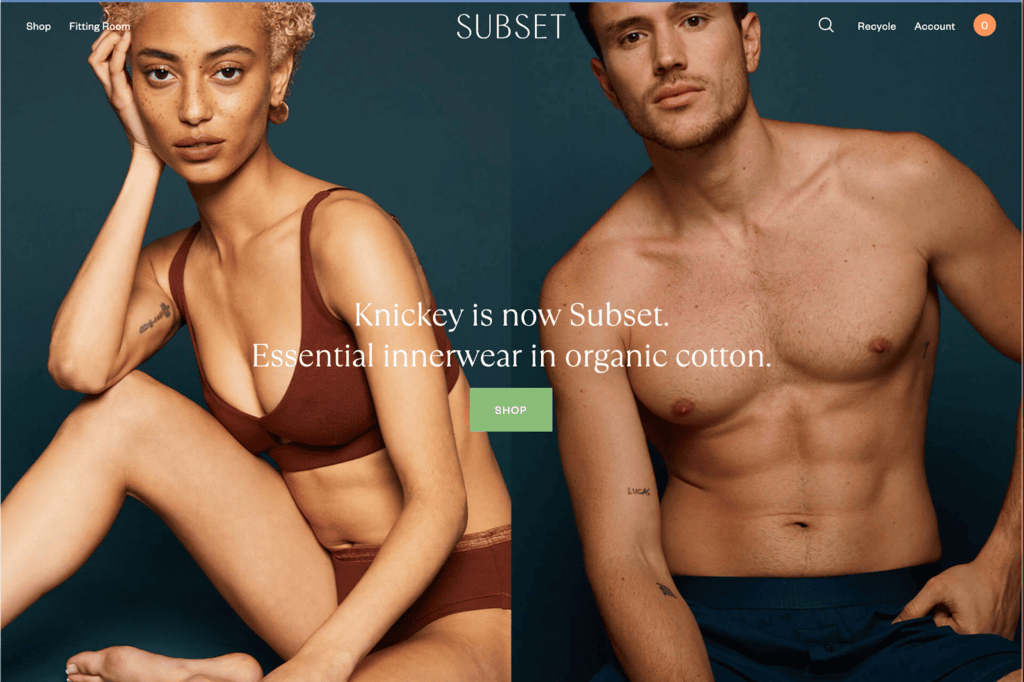
“By seeking out the most environmentally responsible processes, low-impact fabrics and ethical manufacturing, we swap the greenwashing for integrity and accountability. ”
Subset
🌎
How do they ensure their sustainability?
Subset prioritizes sustainability by sourcing a high percentage of low-impact fabrics, offsetting carbon emissions, and facilitating underwear recycling.
- Firstly, they use GOTS-certified organic cotton, TENCEL™, recycled polyester, and regenerated and recycled nylon to reduce environmental impacts. For example, the Maternity Below-Belly Brief items are made with the fabric blend of 95% certified organic cotton and 5% elastane for stretch. Organic cotton, in particular, accounted for 92,1% of their fiber portfolio for 2022. Secondly, they reduce the impact of their carbon emissions with offsetting projects verified by Climate Neutral. For example, in 2022, they supported clean energy projects in India and Kenya. More importantly, they find ways to reduce their carbon footprint, such as using solar-powered energy in their supply chain and localized sourcing.
- Thirdly, in 2018, Subset launched the world’s first recycling program to save underwear, socks, bras, and tights from ending up in landfills. In 2022, they took back nearly 1 million of their own clothing items, as well as those of other brands.
🌐
How do they ensure their ethics?
Subset ensures their ethics by being transparent about their supply chain, all the way from farming to ginning, spinning, knitting, finishing, and packaging.
- Much of their supply chain is certified by Fairtrade International – Small Producers Organisations and Global Organic Textile Standard (GOTS). On top of that, they ensure that workers at their suppliers are paid a living wage.
- Regarding the impact of their operation, Subset discloses on each product page the item’s impact, including not only carbon emission (which is offset) but also the reduction of water usage and synthetic pesticides thanks to their use of organic cotton.
🤝
Are they part of any giving-back programs?
Subset donates new, clean underwear to individuals and communities in need. In 2022, they donated over 2,260 items to organizations across the US, including Bronx Fire Relief, I Support the Girls, and Cultivate Initiatives. They also hold team volunteer days where their staff get together and work toward good causes, such as building an outdoor library.
🛍️
What is their product range?
- Best for: womenswear, menswear
- Product range: bras, panties, loungewear, maternity wear, plus-size
- Price range: $$$
- Size range: 2XS–4XL
All the Wild Roses: Timeless Bohemian Clothing Made With Upcycled and Vintage Fabrics
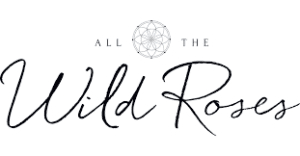
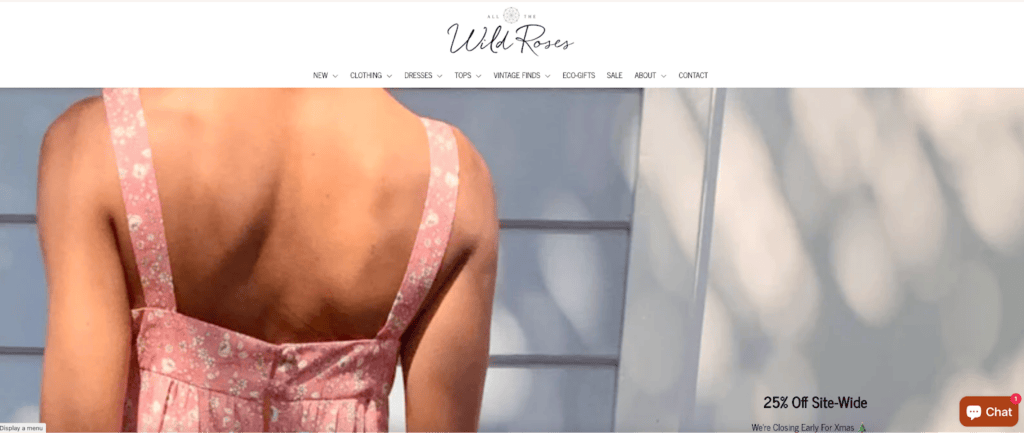
“From designing to our making process, our intention & focus is to create timeless designs that last, to do it in a way that minimises our environmental footprint and to do it with care & respect for our community (including and not limited to our makers, suppliers, customers and more).”
All the Wild Roses
🌎
How do they ensure their sustainability?
All the Wild Roses ensures sustainability by reducing textile waste; sourcing biodegradable, plastic-free materials; and lowering their carbon footprint.
- Their waste reduction incentives include sourcing deadstock fabrics, limiting production runs, and making clothes to order. By curating deadstock, surplus, or remnant fabrics into making their clothes, they help reduce the amount of textile waste in landfills. All the Wild Roses makes up to 90% of their collections with upcycled fabrics. To further minimize textile waste, they run limited batches of clothes, making the most of the upcycled fabrics they find while offering made-to-order service to avoid unnecessary inventory.
- Regarding textile materials, they prioritize biodegradable fibers derived from nature, including upcycled linen, cotton, and rayon. Their packaging is compostable and plastic-free.
- Lastly, they have incentives to lower their carbon footprint, including using 100% renewable and carbon-neutral energy for their design office, offsetting their operations with GreenFleet, a non-profit dedicated to restoring Australian Forest, opting for a carbon neutral shipping service, and operating 100% online which uses about 30% less energy than traditional retail.
🌐
How do they ensure their ethics?
All the Wild Roses has a formal statement covering workers’ rights. They ensure payment of a living wage in the final stage of production. Additionally, they trace their supply chain and visit their suppliers.
🤝
Are they part of any giving-back programs?
All the Wild Roses partners with Opportunity International Australia to provide microloans to women-led businesses in developing countries.
🛍️
What is their product range?
- Best for: kidswear, menswear, womenswear
- Product range: dresses, jumpsuits, tops, skirts, maternity dresses, breastfeeding dresses
- Price range: $$
- Size range: XXS–XXL
Sorella Organics: Organic Cotton Sleepwear and Loungewear


“Housing a collection of sleepwear and loungewear for men, women and maternity we source the softest certified organic and fair trade cotton ensuring each piece is kind on the skin, kind to the environment, and kind to the farmers growing the cotton.”
Sorella Organics
🌎
How do they ensure their sustainability?
Sorella Organics ensures their sustainability by sourcing a high proportion of eco-friendly materials and minimizing waste.
- Firstly, they use certified organic and fair-trade cotton. Both their fabric supplier and manufacturing factory are certified by Global Organic Textile Standard.
- Secondly, they are committed to small production runs to reduce garment waste while improving the quality of their clothes.
🌐
How do they ensure their ethics?
Sorella Organics maintains ethics by working with a GOTS-certified fiber supplier and a manufacturing factory, ensuring environmentally and socially responsible processes in cotton harvesting and clothing production.
- Other certifications held in their supply chain are WRAP, OEKO-TEX®, and FLOCERT (Fairtrade).
- Regarding animal welfare, the brand is vegan, using no animal products and causing no impact on the lives of animals in their manufacturing process.
🤝
Are they part of any giving-back programs?
Sorella Organics is not known to be part of any giving-back programs.
🛍️
What is their product range?
- Best for: womenswear, menswear. kidswear
- Product range: maternity clothes, tops, pants, dresses, nightwear, loungewear
- Price range: $$
- Size range: S–XL
Why Is It Important to Buy Products Made of More Sustainable Fabrics
It is important to buy products made from more sustainable fabrics because a sustainable textile industry has a lower carbon footprint, helps save natural resources, and is better for forests, animals, and humans alike.
Buying Sustainable Fabrics Reduces Your Carbon Footprint
The production of clothing and footwear is estimated to contribute 10% of global greenhouse gas emissions—more than all international flights and shipping combined. If the fashion industry were a country, it would be the fourth largest emitter of carbon dioxide.
One way to reduce the carbon footprint of the clothes you buy is to opt for sustainable fabrics. Sustainable fabrics, which are often made with natural or recycled fibers, have relatively low carbon footprints compared to petroleum-based fabrics. For example, organic cotton made in the US has a carbon footprint of 2.35 kg CO2 (per ton of spun fiber)—a quarter of polyester’s carbon footprint.
Buying Sustainable Fabrics Reduces Demand for Natural Resources and Waste Management
The textile industry uses water and land to grow cotton and other fibers. It is estimated that 79 billion cubic meters of water were used for the sector worldwide in 2015. For example, producing a single cotton T-shirt requires as much water as one person drinks for 2.5 years (2,700 liters of fresh water).
Worse yet, the textile economy is vastly more linear than circular: the largest amount of resources used in clothes ended up in landfills (instead of being recycled to remake clothes). According to a report by the Ellen MacArthur Foundation,
- Less than 3% of materials used in the textile economy in 2015 came from recycled sources.
- In other words, more than 97% of resources used in making clothes are newly extracted.
When clothing items are disposed of within a short period of time—under a year in the case of half of the fast fashion clothes—the natural systems that provide raw materials for fabrics don’t have enough time to recover and regenerate, which could lead to ecological breakdown.
Sustainable fabrics are made with less water and emissions while lasting longer:
- Because they are durable, you don’t need to buy new clothes too often.
- Thus, you help reduce the pressure to extract more resources for making new items.
Similarly, making and consuming sustainable fabrics made with recycled materials reduces the demand for virgin materials while helping tackle waste management.
Buying Sustainable Fabrics Encourages Sustainable Management of Forests
Sustainable plant-based fabrics are made with raw materials from forests and plantations that are sustainably managed, such as complying with FSC standards.
When you buy sustainable plant-based fabrics, you discourage unsustainable forestry practices like illegal logging. You can help reduce deforestation, biodiversity loss, and the effects of climate change.
Buying Sustainable Fabrics Encourages Fairer Treatment of Animals
The fashion industry is rife with animal mistreatment when it comes to making animal-based fabrics like wool or silk. Every year, billions of animals suffer and die for clothing and accessories.
Buying sustainable vegan alternatives can help to reduce the pressure on raising more and more animals to meet the demand for animal-based fabrics while sacrificing their well-being and lives.
Suppose you have to buy fabrics made with, for example, wool or silk; make sure you only choose brands committed to cruelty-free products. In that case, you help advocate better treatments for animals raised within the textile industry.
Using Sustainable Fabrics Encourages Fairer Treatment of Textile Workers
Recent statistics from UNICEF estimated as many as 170 million child laborers worldwide, many of whom were engaged in some form of work in the textile industry. They don’t get paid minimum wages and often work long hours.
When you buy sustainable fabrics from brands transparent about the working conditions at their factories, you discourage the use of child labor and help promote better working conditions for textile workers.
How Can You Generally Buy More Sustainable Fabrics
The key to sustainably buying fabrics is to check on relevant environmental and original certifications.
For natural fabrics:
- Global Organic Textile Standard (GOTS): A globally recognized certification system that ensures a certain threshold of organic content has been met. It covers manufacturing, packaging, labeling, transportation, and distribution (but not what happens in the fields where crops are grown).
- USDA Certified Biobased Product: The USDA BioPreferred® Certification is a voluntary certification offered by the United States Department of Agriculture. The certification identifies products made from plants or other renewable materials.
- Ecolabel: Ecolabel is the official European Union voluntary label recognized worldwide for certified products with a guaranteed, independently verified low environmental impact. The label requires high environmental standards throughout the entire life-cycle: from raw material extraction through production and distribution to disposal. It also encourages companies to develop innovative, durable, easy-to-repair, and recyclable products.
For plant-based semi-natural/semi-synthetic fabrics:
- Forest Stewardship Council: An FSC certification ensures that the wood (or wood-like material) comes from responsibly managed forests that provide environmental, social, and economic benefits.
There are two types of FSC Certification:- FSC Forest Management Certification, with a focus on the origin of the wood—the forest.
- FSC Chain of Custody Certification, which focuses on the path from the forest to the customer’s home.
- Program for Endorsement of Forest Certification: PEFC’s approaches to sustainable forest management are in line with protecting the forests globally and locally and making the certificate work for everyone. Getting a PEFC certification is strict enough to ensure the sustainable management of a forest is socially just, ecologically sound, and economically viable but attainable not only by big but small forest owners.
For recycled fabrics:
- Recycled Claim Standard (RCS): The Textile Exchange RCS was originally developed as an international, voluntary standard that sets requirements for third-party certification of Recycled input and chain of custody.
- The Global Recycled Standard (GRS): The Global Recycled Standard (GRS) is an international, voluntary, full product standard that sets requirements for third-party certification of Recycled Content, chain of custody, social and environmental practices, and chemical restrictions. It can be used for any product with more than 20% recycled material.
For all types of fabrics:
- STeP by OEKO-TEX®: STeP by OEKO-TEX® is an independent certification system for brands, retailers, and manufacturers from the textile and leather industry. It communicates organizational environmental measures, including reducing carbon footprint and water usage.
- OEKO-TEX® Standard 100: OEKO-TEX® labels aim to ensure that products pose no risk to human health (i.e. containing banned chemicals).
Some certifications that are signaling brands’ efforts toward lowered environmental impacts and a circular economy are:
- B Corp Certification: The label B Corp is a certification reserved for for-profit companies. Certified holders are assessed on their social and environmental impacts.
- Cradle2Cradle certification: Cradle2Cradle provides a standardized approach to material circularity. It assesses whether products have been suitably designed and made with the circular economy in mind covering five critical categories: material health, material reuse, renewable energy and carbon management, water stewardship, and social fairness.
Final Thoughts
Maternity clothing is worn temporarily and can be hard to reuse or recycle. Thus, when it comes to both buying and landfilling these items, they can have a significant impact, especially as they often contain fossil-derived stretch materials. With that said, it is important to shop with ethics and sustainability in mind when choosing your next nursing bra or maternity leggings.
By purchasing maternity wear from brands that commit to sustainability, you support their mission to create a fairer and less harmful textile industry for all lives on Earth.
Here is the list (again) of the most sustainable maternity clothing brands:
- Isabella Oliver
- Girlfriend Collective
- Luna + Sun
- Underprotection
- Pact
- Boob Design
- Frugi
- Subset
- All the Wild Roses
- Sorella Organics
To make your use of these clothing items even more sustainable, follow these steps:
- Keep your maternity clothes for as long as possible.
- Rent your maternity clothes if possible.
- At the end-of-life of your maternity clothes, upcycle the materials to extend their usage and arrange for them to be recycled or properly disposed of.
Stay impactful,

Sources
- Impactful Ninja: How Sustainable Are Spandex Fabrics? A Life-Cycle Analysis
- Impactful Ninja: How Sustainable Are Elastane Fabrics? A Life-Cycle Analysis
- Isabella Oliver: Home
- Girlfriend Collective: Home
- Luna + Sun: Home
- Underprotection: Home
- Pact: Home
- Boob Design: Home
- Frugi: Home
- Subset: Home
- All the Wild Roses: Home
- Sorella Organics: Home
- House of Baujken: Home
- B Corporation: House of Baukjen
- Isabella Oliver: Subscription
- Isabella Oliver: Rent Maternity Clothes
- Isabella Oliver: The Pre-Loved Collection
- Isabella Oliver: Our Fabrics
- Impactful Ninja: How Sustainable Are Natural Fabrics? A Life-Cycle Analysis
- Impactful Ninja: How Sustainable Are Organic Cotton Fabrics? A Life-Cycle Analysis
- Impactful Ninja: How Sustainable Are TENCELTM Fabrics? A Life-Cycle Analysis
- Impactful Ninja: How Sustainable Are EcoVero® Fabrics? A Life-Cycle Analysis
- Impactful Ninja: How Sustainable Are Wood-Based Fabrics? A Life-Cycle Analysis
- Impactful Ninja: How Sustainable Are Lyocell Fabrics? A Life-Cycle Analysis
- Impactful Ninja: How Sustainable Are Viscose Fabrics? A Life-Cycle Analysis
- Lenzing: Home
- Isabella Oliver: The Fight Against Deforestation and our partnership with Canopy
- Textile Exchange: Global Recycle Standard
- Impactful Ninja: How Sustainable Are Recycled Fabrics? A Life-Cycle Analysis
- Impactful Ninja: How Sustainable Are Sheep Wool Fabrics? A Life-Cycle Analysis
- Impactful Ninja: How Sustainable Are Cashmere Fabrics? A Life-Cycle Analysis
- Impactful Ninja: How Sustainable Are Polyamide Fabrics? A Life-Cycle Analysis
- Baukjen: Packaging
- Isabella Oliver: Sustainability Impact Report Q3 2022
- Isabella Oliver: Our Factories
- Isabella Oliver: Code of Conduct
- Isabella Oliver: Planet + People
- Girlfriend Collective: Maternity
- Girlfriend Collective: About
- Girlfriend Collective: How is your recycled fabric made?
- Girlfriend Collective: Is everything eco-friendly?
- Girlfriend Collective: The Microfiber Filter
- Girlfriend Collective: Recycle. Reuse. Regirlfriend
- EcoCart: Home
- Girlfriend Collective: Are you carbon-neutral
- Good On You: Brand Directory | Girlfriend Collective
- SA8000 Standards: Home
- Luna + Sun: Australian Made Clothing
- Impactful Ninja: How Sustainable Are Linen Fabrics? A Life-Cycle Analysis
- OEKO-TEX: OEKO-TEX STANDARD 100
- Luna + Sun: Sustainability
- Impactful Ninja: How Sustainable Are Organic Cotton Fabrics? A Life-Cycle Analysis
- UPPAREL: Home
- AirRobe: Home
- Rntr: Home
- Luna + Sun: Transparency
- Ethical Clothing Australia: Home
- One Tree Planted: Home
- Underprotection: Maternity Lingerie
- B Corporation: Underprotection
- Good On You: Brand Directory | Underprotection
- Impactful Ninja: How Sustainable Are Lyocell Fabrics? A Life-Cycle Analysis
- Impactful Ninja: How Sustainable Are Recycled Wool Fabrics? A Life-Cycle Analysis
- Textile Exchange: Responsible Wool Standard
- Impactful Ninja: How Sustainable Are Sheep Wool Fabrics? A Life-Cycle Analysis
- Impactful Ninja: How Sustainable Are Synthetic Fabrics? A Life-Cycle Analysis
- Underprotection: Materials
- Textile Exchange: Global Recycle Standard
- Impactful Ninja: How Sustainable Are Polyester Fabrics? A Life-Cycle Analysis
- Impactful Ninja: How Sustainable Are Nylon Fabrics? A Life-Cycle Analysis
- Impactful Ninja: How Sustainable Are Spandex Fabrics? A Life-Cycle Analysis
- Impactful Ninja: How Sustainable Are Elastane Fabrics? A Life-Cycle Analysis
- Underprotection: Packaging
- Underprotection: Repair and Rewards
- Underprotection: Wash & Care
- Underprotection: Take-back program
- Underprotection: Upcycled
- Underprotection: I Tråd Med Verden
- Underprotection: Sustainable Report 2020
- Underprotection: Production
- Underprotection: Code of Conduct
- International Labour Organization: Fundamental Principles and Rights at Work
- Worldwide Responsible Accredited Production (WRAP): Home
- Sedex: Home
- Amfori: BSCI
- Underprotection: Green Friends
- Underprotection: TREEAPP
- Underprotection: ReSea
- Pact: Women’s Organic Cotton Maternity
- Good On You: Brand Directory | Pact
- Global Organic Textile Standard: Home
- Impactful Ninja: How Sustainable Are Organic Cotton Fabrics? A Life-Cycle Analysis
- VelaTM paper bags: Home
- Pact: Responsible Packaging
- SimpliZero: Home
- Pact: Sustainability, Certified
- Pact: Give Back Box
- Boob Design: Boob’s Sustainability Work
- Boob Design: Rent Maternity Clothes
- Impactful Ninja: How Sustainable Are Organic Cotton Fabrics? A Life-Cycle Analysis
- Impactful Ninja: How Sustainable Are Organic Wool Fabrics? A Life-Cycle Analysis
- Impactful Ninja: How Sustainable Are Viscose Fabrics? A Life-Cycle Analysis
- Impactful Ninja: How Sustainable Are Modal Fabrics? A Life-Cycle Analysis
- Impactful Ninja: How Sustainable Are Lyocell Fabrics? A Life-Cycle Analysis
- Lenzing: Home
- Impactful Ninja: How Sustainable Are Recycled Polyester Fabrics? A Life-Cycle Analysis
- Impactful Ninja: How Sustainable Are Recycled Nylon Fabrics? A Life-Cycle Analysis
- Impactful Ninja: How Sustainable Are ECONYL® Fabrics? A Life-Cycle Analysis
- Boob Design: OUR SUSTAINABLE MATERIALS
- Textile Exchange: Global Recycle Standard
- Hyber: Home
- Boob Design: LONG LIVE YOUR CLOTHES – AND THE ENVIRONMENT
- Boob Design: Our factories
- SA International: SA8000
- Bluesign: Home
- OEKO-TEX: Home
- Global Organic Textile Standard (GOTS): Home
- Textile Exchange: Organic Content Standard
- Frugi: Organic Cotton Maternity Wear
- Impactful Ninja: How Sustainable Are Organic Cotton Fabrics? A Life-Cycle Analysis
- Frugi: Love Organic
- Global Organic Textile Standard (GOTS): Home
- Impactful Ninja: How Sustainable Are Recycled Polyester Fabrics? A Life-Cycle Analysis
- Frugi: Recycled Plastic Clothing
- Frugi: Circularity
- Frugi: Circular Collection
- Frugi: RECYCLE ME
- Frugi: Fabric Care
- Soil Association Certification: Home
- Frugi: Giving back is in our DNA
- Whale and Dolphin Conservation: Home
- Save The Children: Home
- Transforming Lives for Good: Home
- Subset: Maternity Underwear
- Subset: Becoming Carbon Neutral
- Good On You: Brand Directory | Subset
- Subset: SUBSET x Supercircle | Recycle your rejects
- Global Organic Textile Standard: Home
- Impactful Ninja: How Sustainable Are Organic Cotton Fabrics? A Life-Cycle Analysis
- Impactful Ninja: How Sustainable Are TENCEL Fabrics? A Life-Cycle Analysis
- Impactful Ninja: How Sustainable Are Recycled Polyester Fabrics? A Life-Cycle Analysis
- Impactful Ninja: How Sustainable Are Recycled Nylon Fabrics? A Life-Cycle Analysis
- Subset: Maternity Below-Belly Brief
- Impactful Ninja: How Sustainable Are Elastane Fabrics? A Life-Cycle Analysis
- Subset: Our Materials
- Subset: 2022 Impact Report
- Subset: Organic Cotton Supply Chain
- Fairtrade: Fairtrade Standard for Small-Scale Producer Organisations
- I Support the Girls: Home
- Cultivate Initiatives: Home
- All the Wild Roses: Maternity Clothing
- B Corporation: All the Wild Roses
- All the Wild Roses: SUSTAINABLE PRACTICES
- Impactful Ninja: How Sustainable Are Linen Fabrics? A Life-Cycle Analysis
- Impactful Ninja: How Sustainable Are Cotton Fabrics? A Life-Cycle Analysis
- Impactful Ninja: How Sustainable Are Rayon Fabrics? A Life-Cycle Analysis
- Good On You: Brand Directory | All The Wild Roses
- GreenFleet: Home
- All the Wild Roses: GIVING BACK
- Sorella Organics: Maternity
- Good On You: Brand Directory | Sorella Organics
- Sorella Organics: About Us
- Global Organic Textile Standard: Home
- Worldwide Responsible Accredited Production (WRAP): Home
- OEKO-TEX: Home
- Flo Cert: Home
- Sorella Organics:
- Sorella Organics:
- Sorella Organics:
- European Parliament: The impact of textile production and waste on the environment (infographic)
- Science Direct: The challenge of “Depeche Mode” in the fashion industry – Does the industry have the capacity to become sustainable through circular economic principles, a scoping review
- Science Direct: Carbon Footprint of Textile and Clothing Products
- European Parliament: Environmental impact of the textile and clothing industry
- European Parliament: What if fashion were good for the planet?
- Ellen MacArthur Foundation: A New Textiles Economy: Redesigning fashion’s future
- McKinsey: Style that’s sustainable: A new fast-fashion formula
- Forest Stewardship Council: Home
- Our World in Data: Deforestation and Forest Loss
- Our World in Data: Renewable Energy
- Peta: Animals Used For Clothing
- The Guardian: Child labour in the fashion supply chain
- Impactful Ninja: How Sustainable Are Natural Fabrics? A Life-Cycle Analysis
- Global Organic Textile Standard (GOTS): Home
- BioPreferred: WHAT IS THE BIOPREFERRED PROGRAM?
- European Commission: Environment | EU Ecolabel
- Impactful Ninja: How Sustainable Are Semi-Natural/Semi-Synthetic Fabrics? A Life-Cycle Analysis
- Forest Stewardship Council
- FSC Forest Management Certification
- FSC Chain of Custody Certification
- Textile Exchange: The RCS and GRS are designed to boost the use of recycled materials
- Program for Endorsement of Forest Certification
- Impactful Ninja: How Sustainable Are Recycled Fabrics? A Life-Cycle Analysis
- Textile Exchange: Recycled Claim Standard
- Textile Exchange: Global Recycled Standard
- OEKO-TEX: Certification according to STeP by OEKO-TEX®
- OEKO-TEX: OEKO-TEX® Standard 100
- B Corp Certification: Home
- C2CCertified: Home




